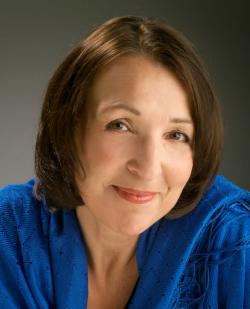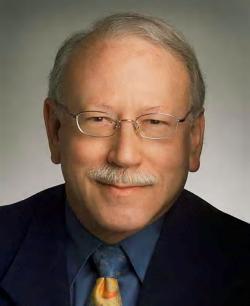| |
Abstract: Modern cosmology, the study of the universe as a whole, now explains far more than just the Big Bang. It tells us that everything we can see - the stars, gas, even distant galaxies - are only half of one percent of what is actually out there. Dark matter and dark energy fill the universe and shape it on large scales. Astronomical observations are revealing how the universe evolved and how it operates, not just on cosmic size scales but on all size scales – including that of Earth. President Obama on election night challenged America to think 100 years into the future, but this cannot be done successfully without a Big Picture. A meaningful science-based understanding of our universe could provide a new perspective on the global problems and long-range opportunities of our time. This lecture includes beautiful videos based on observations and supercomputer simulations. It makes a connection between the new scientific cosmology and our human future.
Related Presentation: "Full of dark matter collapsing the galaxies into being and dark energy accelerating them apart, the evolving universe, according to 2009-10 Terry lecturers JOEL R. PRIMACK and NANCY ELLEN ABRAMS, has turned out to be wildly more interesting than the image of an empty space scattered with celestial objects. To the extent that people around the world accept scientific reality, they argue, we have grounds for agreement for the first time on a shared creation story based on modern cosmology and biology."
Follow this link to read the entire text on these lectures and to view the lectures online: www.yale.edu/terrylecture/thisyear.html

Biography: Nancy Ellen Abrams is the co-author, with world-renowned cosmologist Joel R. Primack, of The View from the Center of the Universe: Discovering Our Extraordinary Place in the Cosmos (Penguin/Riverhead 2006). She has a B.A. in the history and philosophy of science from the University of Chicago, a law degree from the University of Michigan, and a diploma in international trade and Mexican law from the Escuela Libre de Derecho in Mexico City. She was a Fulbright Scholar and a Woodrow Wilson Designate. She is a writer whose work has appeared in many journals and magazines and several book anthologies. With her husband, Joel R. Primack, she co-authored a prize-winning article on quantum cosmology and Kabbalah, as well as numerous articles on science policy, space policy, and possible cultural implications of modern cosmology. The most recent ones are posted at physics.ucsc.edu/cosmo/primackabrams.html. Nancy and Joel have given nearly 100 talks at universities, science museums, churches, synagogues, and other public venues around the world since the publication of their book. Their appearances are listed on their joint website, viewfromthecenter.com, along with interviews and feature articles.
In October 2009 Nancy and Joel gave the Terry Lectures at Yale University, a prestigious series in science and meaning that was established in 1905. The lectures can be seen at www.yale.edu/terrylecture/thisyear.html In spring 2011 Yale University Press will publish a book based on their 2009 lectures, tentatively entitled Cosmic Society: the Dark Matter Universe and the Human Future.
Nancy is also a songwriter who has performed at conferences, concerts, and
events in nineteen countries, released three albums, and been featured on National Public Radio and television. Her song lyrics were used as chapter headings in Powerline by the late Senator Paul Wellstone. New York Times science writer Dennis Overbye’s bestseller, Lonely Hearts of the Cosmos, describes Nancy’s songs and closes with the complete lyrics to one she wrote for and performed at an astronomy conference. Together Nancy and Joel developed the award-winning course “Cosmology and Culture” and have been co-teaching it since 1996 at the University of California, Santa Cruz. Several songs on Nancy’s 2002 album, Alien Wisdom, explore themes of cosmology and culture (see her music website, www.expandinguniverse.org). She has been intrigued by science’s border with myth since studying with Mircea Eliade at the University of Chicago. She works as a scholar to put the discoveries of modern cosmology into a cultural context and as awriter and musician to communicate their possible meanings at a deeper level.
Nancy has also had a long-term interest in the role of science in shaping a new politics. She has worked in this area for an international law firm, a European environmental think tank, the Ford Foundation, and the Office of Technology Assessment of the U.S. Congress. With R. Stephen Berry of the National Academy of Sciences she co-created the technique of Scientific Mediation, which permits government agencies to make informed and foresightful policy decisions on issues where science is crucial but disputed. Scientific Mediation aims not to resolve scientific controversy, which can only be done by scientific research, but to make the essence of the dispute transparent to the non-scientists making the practical political decision. She has consulted on the use of this novel procedure for Sweden, the state governments of California and Wisconsin, Exxon Nuclear, and others, and Scientific Mediation has become standard procedure in the Swedish Department of Industry.
Nancy served six years on the Board of Directors of Shakespeare Santa Cruz and is a patron of the arts, knowing that there cannot be a new picture of reality, whether cosmological, political, or spiritual without the active participation of artists.
Website: www.viewfromthecenter.com
Contact: Nancy
can be reached by e-mail at nancysview@gmail.com for additional information about this Forum session.
 Biography: Joel R. Primack, Distinguished Professor of Physics at the University of California, Santa Cruz, specializes in the formation and evolution of galaxies and the nature of the dark matter that makes up most of the mass in the universe. Primack received his A.B. in Physics summa cum laude from Princeton in 1966 and his Ph.D. in Physics from Stanford in 1970. He became a Junior Fellow of the Society of Fellows of Harvard University, and in 1973 joined the UCSC faculty. After helping to create what is now called the "Standard Model" of particle physics, Primack began working in cosmology in the late 1970s and he became a leader in the new field of particle astrophysics. He is one of the principal originators and developers of the theory of Cold Dark Matter, which has become the basis for the standard modern picture of structure formation in the universe. With support from the National Science Foundation, NASA, and the Department of Energy, he is currently using supercomputers to simulate and visualize the evolution of the universe under various assumptions, and comparing the predictions of these theories to the latest observational data. Primack has supervised part or all of the research of 40 graduate students and 10 postdocs. He was made a Fellow of the American Physical Society (APS) in 1988 "for pioneering contributions to gauge theory and cosmology." He was elected to the Executive Committee of the APS Division of Astrophysics 2000-2002. He has won awards for his research from the A. P. Sloan Foundation and the Alexander von Humboldt Foundation.
Primack's research in cosmology is described in most modern books on the subject, and he has been profiled at some length in several books including New York Times science writer Dennis Overbye's Lonely Hearts of the Cosmos and former Time magazine science editor Michael Lemonick's The Light at the Edge of the Universe. He was one of the main advisors for the Smithsonian Air and Space Museum's 1996 IMAX film Cosmic Voyage. In addition to more than 200 technical articles in professional journals, Primack has written a number of articles aimed at a more popular audience. These include the articles on "gravitation," "matter," "dark matter," "dark energy," and other physics and astronomy topics in the World Book Encyclopedia, and articles in publications such as Nature, Science, Astronomy, Sky and Telescope, Beam Line, California Wild, the McGraw-Hill Encyclopedia of Science and the Encyclopedia of Astronomy and Astrophysics. Primack has also been the Lansdowne Lecturer at the University of Victoria, the J. Robert Oppenheimer Memorial Lecturer at Los Alamos, and the Buhl Lecturer at Carnegie Mellon University.With his wife and collaborator Nancy Ellen Abrams, Primack developed the award-winning course “Cosmology and Culture,” and they have been co-teaching it since 1996 at the University of California, Santa Cruz. This course won awards from the John Templeton Foundation and the American Council of Learned Societies, and was the basis for their book The View from the Center of the Universe: Discovering Our Extraordinary Place in the Cosmos (Penguin/Riverhead 2006), now also published in several foreign editions (see http://viewfromthecenter.com/, which also lists their many public talks). At Yale University in October 2009 they gave the Terry Lectures (http://www.yale.edu/terrylecture/thisyear.html), which will be published as a book by Yale University Press in 2011.
Since he was a graduate student, Primack has actively sought to get better scientific advice into government. He was a founder of the Union of Concerned Scientists and he served on the board of the Federation of American Scientists (FAS). In 1973 he started the Congressional Science Fellows Program of the American Association for the Advancement of Science (AAAS) and the APS, through which scientific societies fund Ph.D. scientists to work in Congress for a year. This program has since grown to include many fields of science, and it inspired several other science fellowship programs. In 1977 Primack shared with Frank von Hippel the APS Forum on Physics and Society Award for their book Advice and Dissent: Scientists in the Political Arena (Basic Books, 1974; New American Library, 1976). Primack helped create the NSF Science for Citizens Program to fund scientists to advise public interest organizations. He was a charter member of the AAAS Committee on Scientific Freedom and Responsibility, and he started the AAAS Science and Human Rights program to take up the cases of scientists persecuted by foreign and bring international pressure to bear to free them. In 1995 Primack was made an AAAS Fellow "for pioneering efforts in the establishment of the AAAS Congressional Science Fellows Program and for dedication to expanding the use of science in policymaking throughout government." In 1987-89 Primack led the FAS Space Nuclear Power Arms Control project, which succeeded in ending the USSR’s space nuclear reactor program. His popular articles on efforts to protect the near-Earth space environment, some co-authored with Nancy Ellen Abrams, have appeared in Bulletin of the Atomic Scientists, Science, Scientific American, and Technology Review. Primack has also served as an advisor to and participant in the Science and the Spiritual Quest project and as chairman of the advisory committee for the AAAS Program of Dialogue on Science, Ethics, and Religion 2000-2002.
Primack was a member of the APS Panel on Public Affairs 2002-2004, he chaired an APS committee reporting on NASA funding for astronomy 2004, he chaired the APS Forum on Physics and Society 2005-06, and he chaired the committee on the APS Andrei Sakharov Prize on science and human rights in 2009. He has served on numerous advisory panels to DOE, NASA, and NSF, and on the Beyond Einstein Program Assessment Committee of the National Academy of Sciences/National Research Council 2007-08. In January 2010, Primack became the director of the new University of California systemwide High-Performance AstroComputing Center (HIPACC).
Website: www.viewfromthecenter.com
Contact: Joel
can be reached by e-mail at joel@physics.ucsc.edu for additional information about this Forum session.
|
|
|

